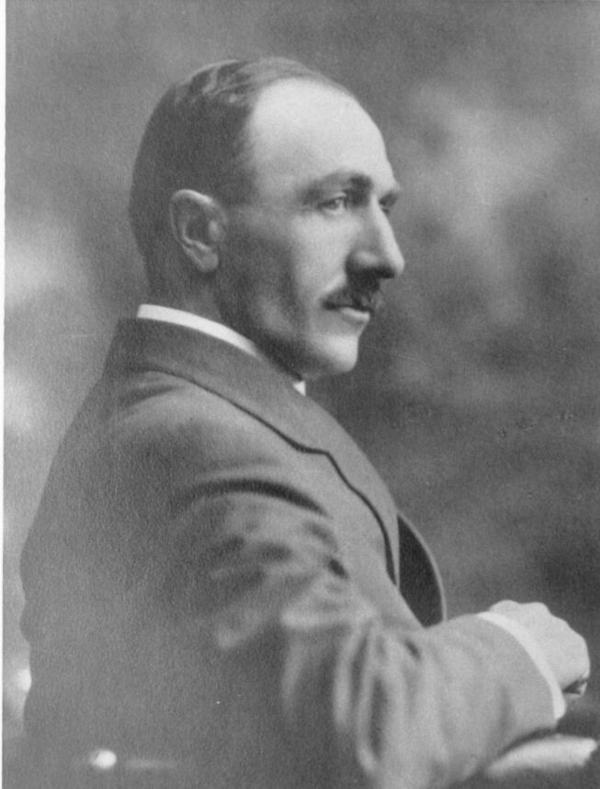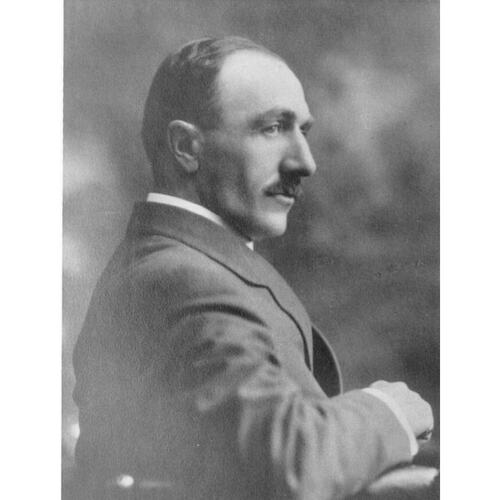
Source: Courtesy of Wikimedia Commons
LEA, WALTER MAXFIELD, farmer, editor, and politician; b. 10 Feb. 1874 in Tryon, P.E.I., son of William Charles Lea and his second wife, Annie Murphy; m. there 18 Oct. 1899 Helena Esma Maud Mary Rogerson, and they had three sons and two daughters; d. 10 Jan. 1936 in Charlottetown.
Originally from Lincolnshire, England, the Lea family settled in the Tryon area of Prince Edward Island in about 1818, and several of its members became leading farmers in the district. Walter Lea went to school in nearby Victoria (Victoria-by-the-Sea), which was developing as a port and service centre for the area. He took a short course at the Nova Scotia School of Agriculture in Truro and joined his father in working Riverside Farm, the family’s mixed-farming property of more than 200 acres, west of Victoria. High milk and butterfat yields were marks of success at a time when the dairy industry was increasingly important to the province, and the Lea farm, which supplied the local creamery for over three decades, became known for the quality of its Holstein cattle as well as for its Percheron horses. Walter was an early and enthusiastic promoter of dairy cooperatives, and he had a particular interest in the improvement of livestock by better breeding. Respected for his expertise and scientific approach, he frequently served as a livestock judge at agricultural fairs across the Maritimes, as well as in Ontario and Saskatchewan. Lea held a number of executive positions with the Holstein-Friesian Association of Canada, and in 1921, after his herd had to be destroyed because of an outbreak of bovine tuberculosis, he supported the campaign to make the province disease-free, an accomplishment of the Conservative government of James David Stewart two years later.
Lea was 41 years old before he followed his father, who had been a member of the House of Assembly from 1872 to 1879, into public office. He was first elected to the Legislative Assembly (as it was known from 1893) in 1915, representing 4th Prince as a member of the Liberal opposition. He would be returned in 1919, defeated in 1923, and re-elected in 1927, 1931, and 1935. Premier John Howatt Bell*, who also represented the Tryon area, chose Lea as commissioner (minister) of agriculture, a post he held from 1919 to 1923. He was responsible for the establishment of the province’s Agricultural and Technical School, which occupied the Government House site made available by the closure of the Military Hospitals Commission facility in 1920. The school, primarily funded by Ottawa, would be shut down in 1925 by the Stewart government when federal money ran out.
For several years in the mid 1920s Lea was editor of the agriculture section of the Guardian. He found the job pleasing and relinquished it only after his re-election in 1927, when his party returned to power and he was made commissioner of agriculture and provincial secretary-treasurer by Premier Albert Charles Saunders*. The Liberal legislative agenda was heavily weighted towards agricultural issues, and Lea appears to have been deeply involved in the work of his department. He wrote an article on “Improved live stock breeding” for its 1927 annual report, and in 1928 he was a member of a provincial delegation that examined the farming practices of England, Scotland, and Denmark. When Saunders was appointed to the Supreme Court of Prince Edward Island, Lea was called on to form a government, and he took office on 20 May 1930, choosing to serve as both premier and commissioner of agriculture.
The effects of the Great Depression were not felt as immediately on the Island as they were elsewhere in Canada. The loss of agricultural markets was initially seen as temporary and Lea, the province’s first farmer-premier, responded with a program of restraint. In a 1930 article for his department’s annual report, “Economy in production,” he argued that simple measures that could be taken by farmers to keep down costs would overcome their economic difficulties. Lea applied this thinking to the broader situation facing the province, and in the 1931 budget the government reduced its bonded debt. The move was contrary to the expectations of the populace, however, at a time when other provinces were beginning to borrow to pay for much-needed relief. In the 1931 election Lea also faced a Tory opposition that held out the hope of improving the Island’s relations with the Conservative federal government of Richard Bedford Bennett*.
When the poll results of 6 August were counted, the Conservatives, still led by Stewart, had an 18 to 12 majority in the Legislative Assembly. Lea retained his seat, though by only nine votes, and there was no move to oust him as Liberal party leader. Historian Edward MacDonald has noted that the Tory victory, coming at a time when the depression was just beginning to settle in, was “probably the worst thing that could have happened to the Conservatives.” For the next four years Lea was able to use the general public discontent to his party’s advantage. While trying to balance the small revenues and expenditures of the province the Conservatives were hit with the capital costs of replacing two major institutions that burned during the winter of 1931–32, Falconwood Hospital and Prince of Wales College. The economic decline of the province over the previous 60 years meant that there was little appetite among Islanders for more borrowing, and the Liberals were able to attack the Tories for increasing the debt while offering a solution of restraint.
The 1935 campaign was a difficult one for Lea. Suffering from illness, he was forced to delegate much of the work to Thane Alexander Campbell*, a Summerside lawyer and member of the Legislative Assembly. Campbell has often been given most of the credit for winning the election, but Lea’s role was not that of a bystander. Although he was in hospital at the start of the contest and remained ill for much of the campaign, the Liberal plan of attack, which he had been actively involved in developing, had been made public in early April, more than three months before the election was held. Lea made only one appearance on the stump, but he did make radio addresses, and he was aided by the enthusiastically biased Charlottetown Patriot.
It is unlikely that the Conservatives could have continued in office even without a substantive opposition campaign, or that the shift in party loyalties of the electorate was dependent on the campaign itself. The depression had eroded public confidence in the ability of the Conservatives in both Ottawa and Charlottetown to effect change, and the economic problems of the Island would have been blamed on whichever party was in power. Additionally, a change of premiers in midterm gave the Liberals an easy target. William Joseph Parnell MacMillan*, a successful doctor from the capital, had succeeded Stewart upon his death in office in 1933, and his posturing in the legislature contrasted with the rural modesty of Lea. MacMillan was a capable speaker and debater, but his brash style alienated average voters, many of whom saw his government as aloof and inefficient.
The surprise of 23 July 1935, then, was not the fact of the Liberal victory, but its magnitude. In a province where majorities were usually quite small and the popular vote seldom strayed far above 51 per cent for the winning side, the Liberals had scored almost 60 per cent, with many victors obliterating their opponents. For what was believed to be the first time in the history of the British Commonwealth, no opposition members had been elected; Lea’s party had taken all 30 seats in the Legislative Assembly. “Island votes for Liberal dictatorship,” warned the Guardian, which had supported the Conservatives, while the Summerside Journal, also a Tory organ, did not even bother to report the stunning loss. The party would not win another provincial election for more than two decades.
The first session of the new government began on 25 Sept. 1935 and lasted but one day. Lea assumed the portfolios of agriculture and provincial secretary-treasurer in addition to the premiership, and Campbell became attorney general. A number of financial measures were passed, including the coverage of an overdraft created by the Conservatives and the recall of a high-interest bond issue. The total lack of opposition resulted in the smooth and rapid passage of legislation, and the Liberals were jubilant.
Lea appears to have been back in form for this short session, and in December he travelled to Ottawa for the Dominion–Provincial Conference hosted by Prime Minister William Lyon Mackenzie King*. By the next month, however, he was critically ill, and on 10 Jan. 1936 Walter Lea died of pneumonia in Charlottetown’s Prince Edward Island Hospital. Obituary notices dropped the usual partisanship and MacMillan, his political rival, praised him as “a true son of the soil he loved so well for many years … without doubt the leading agriculturist of this Island province.”
Walter Lea’s political legacy may have been his rebuilding of the Liberal Party, but as the Island’s first farmer-premier his influence on agriculture, which he supported and promoted as the primary industry of the province, was even more significant. Both inside and outside of government he advocated a professional and scientific approach to farming, and he did so with credibility because of his own success and leadership in the field. Perhaps most telling is the inscription on Lea’s gravestone in the Tryon People’s Cemetery: “The People Trusted Him.”
Walter Maxfield Lea is the author of two articles in the provincial Dept. of Agriculture’s Annual report (Charlottetown): “Improved live stock breeding” (1927): 29–31; and “Economy in production” (1930): 25–28.
PARO, Acc. 4077 (The Lea family of Prince Edward Island). Charlottetown Patriot, 10, 11 Jan. 1936. [G.] E. MacDonald, If you’re stronghearted: Prince Edward Island in the twentieth century (Charlottetown, 2000). W. E. MacKinnon, The life of the party: a history of the Liberal Party in Prince Edward Island ([Charlottetown], 1973). R. W. Manning, “Cows and convalescents: Government House as health and education centre, 1917–1924,” Island Magazine (Charlottetown), no.24 (fall/winter 1988): 19–24. Minding the house (Weeks). Walter Shaw, Tell me the tales (Charlottetown, 1975).
Cite This Article
Harry Tinson Holman, “LEA, WALTER MAXFIELD,” in Dictionary of Canadian Biography, vol. 16, University of Toronto/Université Laval, 2003–, accessed December 30, 2025, https://www.biographi.ca/en/bio/lea_walter_maxfield_16E.html.
The citation above shows the format for footnotes and endnotes according to the Chicago manual of style (16th edition). Information to be used in other citation formats:
| Permalink: | https://www.biographi.ca/en/bio/lea_walter_maxfield_16E.html |
| Author of Article: | Harry Tinson Holman |
| Title of Article: | LEA, WALTER MAXFIELD |
| Publication Name: | Dictionary of Canadian Biography, vol. 16 |
| Publisher: | University of Toronto/Université Laval |
| Year of publication: | 2018 |
| Year of revision: | 2018 |
| Access Date: | December 30, 2025 |



